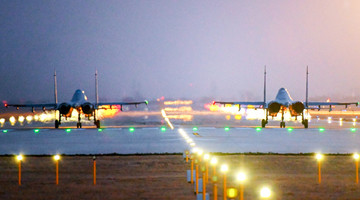Lt. Gen. Dennis Gyllensporre of Sweden - Force Commander of the United Nations Multidimensional Integrated Stabilization Mission in Mali (MINUSMA) reviews the Chinese peacekeeping force during the UN Peace Medal of Honor awarding ceremony held by MINUSMA on March 7, 2019. (Photo by Jia Chunming)
By Ma Debao
At present, the world is changing at a pace that hasn’t been seen in the past one hundred years, and China’s national security is under a more and more complex, comprehensive and changeable circumstance. China did not increase its military spending this year despite rapid economic development. This is because China considers military expenditure not only from the perspective of defense need and the possibility of economic support, but also from the political perspective, reflecting the responsibility to maintain world peace.
Responsibility-oriented
In recent years, while the international environment has developed in a peaceful and stable manner in general, some contradictions and problems have accumulated. Some countries pursue unilateralism, constantly “quitting international treaties and organizations,” provoking global trade wars, and increasing military spending especially in high-end strategic sectors such as space, network technology, and nuclear power, thus seriously impacting world peace and stability.
To tackle these shocks, some countries have increased the development of countering armed forces and accelerated the pace of combat preparations. Under such circumstances, China continues to adhere to the consistent policy of not engaging in an arms race with any country, has not substantially increased military spending, and joins hands with international society to prevent the militarization of international relations. It is a manifestation of responsibility and courage.
Peace-oriented
China’s peace-oriented approach is not only enshrined in China's traditional culture, but also has risen to the level of a conscious national strategy. In that case, it’s impossible for China to take the initiative to resolve conflicts with other countries in the form of war or threat of war, regardless how small or weak the opponents are. The conscious constraints of cherishing peace have effectively restrained military spending in this peaceful environment.
Defense-oriented
Chinese people never recognize the idea of “a strong country is bound to seek hegemony”. The white paper “China’s Military Strategy” released by the Chinese government in 2015 publicly declared to the world that China still pursues a national defense policy that is purely defensive in nature and a military strategy of active defense. At the same time, China unswervingly defends its core interests. At any time, no country or no one should expect China to take actions that will harm its core interests.
Compared to strategic offensives, the resource requirements for implementing strategic defenses are relatively small. China's modest increase in military spending is only a quarter of the U.S. military budget in 2019 in absolute value. This increase is acceptable given China’s defensive strategy.
People-oriented
China is the largest developing country in the world with a population of nearly 1.4 billion. In 2018, the per capita GDP has not yet reached the global average level although the total GDP exceeded 90 trillion yuan. Judging from the human development index, China’s development level is still relatively backward and there are some obvious weaknesses.
From the 35-trillion-yuan budget allocation of China’s central government fiscal expenditure in 2019, the defense spending increased by only 7.5 percent, while science and technology spending increased by 13.4 percent. According to the budget, the central general public budget expenditure is 33.94 trillion yuan, and the military expenditure only accounted for about 3.5 percent.
In the U.S., the fiscal expenditure of the federal government in fiscal year 2019 totaled 4.407 trillion U.S. dollars. The military expenditures reached 716 billion U.S. dollars, accounting for 16 percent of the total fiscal expenditure. The comparison shows that China pays more attention to investing its limited financial resources in promoting economic and social development.
In a peaceful environment, the political orientation of China’s military spending is long-term and stable. Only when the war is approaching, would China rapidly increase its military spending
(The author is with the Academy of Military Sciences of the Chinese PLA.)









